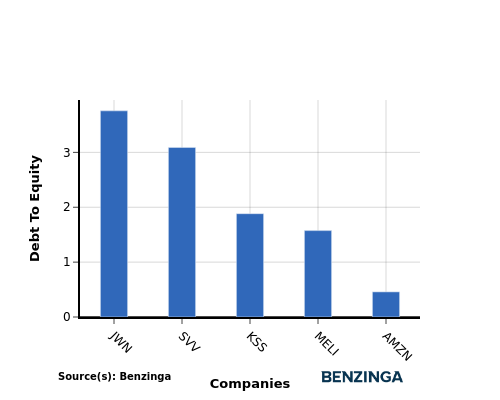Amidst the fast-paced and highly competitive business environment of today, conducting comprehensive company analysis is essential for investors and industry enthusiasts. In this article, we will delve into an extensive industry comparison, evaluating Amazon.com AMZN in comparison to its major competitors within the Broadline Retail industry. By analyzing critical financial metrics, market position, and growth potential, our objective is to provide valuable insights for investors and offer a deeper understanding of company's performance in the industry.
Amazon.com Background
Amazon is the leading online retailer and marketplace for third party sellers. Retail related revenue represents approximately 75% of total, followed by Amazon Web Services' cloud computing, storage, database, and other offerings (15%), advertising services (5% to 10%), and other the remainder. International segments constitute 25% to 30% of Amazon's non-AWS sales, led by Germany, the United Kingdom, and Japan.
| Company | P/E | P/B | P/S | ROE | EBITDA (in billions) | Gross Profit (in billions) | Revenue Growth |
|---|---|---|---|---|---|---|---|
| Amazon.com Inc | 36.76 | 7.53 | 3.42 | 7.34% | $38.55 | $37.37 | 10.49% |
| Alibaba Group Holding Ltd | 19.56 | 2.31 | 2.42 | 5.01% | $59.0 | $117.63 | 7.61% |
| PDD Holdings Inc | 12.63 | 4.63 | 3.67 | 9.38% | $29.18 | $59.65 | 44.33% |
| MercadoLibre Inc | 56.63 | 24.87 | 5.21 | 15.3% | $0.96 | $2.75 | 37.42% |
| JD.com Inc | 11.49 | 1.87 | 0.41 | 4.21% | $15.92 | $45.04 | 33.26% |
| Coupang Inc | 294.88 | 10.38 | 1.42 | 3.76% | $0.44 | $2.49 | 21.4% |
| eBay Inc | 16.85 | 6.01 | 3.24 | 12.84% | $0.76 | $1.86 | 0.66% |
| Vipshop Holdings Ltd | 8.29 | 1.54 | 0.59 | 6.31% | $1.47 | $4.96 | 60.69% |
| Ollie's Bargain Outlet Holdings Inc | 33.50 | 3.91 | 2.94 | 4.14% | $0.06 | $0.21 | 28.92% |
| Dillard's Inc | 10.16 | 3.31 | 0.91 | 11.41% | $0.21 | $0.63 | 41.38% |
| MINISO Group Holding Ltd | 15.84 | 3.98 | 2.44 | 6.68% | $0.88 | $2.03 | 19.29% |
| Nordstrom Inc | 14.01 | 3.57 | 0.27 | 15.61% | $0.44 | $1.69 | -2.17% |
| Macy's Inc | 6.73 | 0.85 | 0.17 | 7.86% | $0.68 | $3.02 | -4.39% |
| Savers Value Village Inc | 41.12 | 2.63 | 0.76 | -0.44% | $0.04 | $0.22 | 5.02% |
| Kohl's Corp | 9.59 | 0.28 | 0.06 | 1.26% | $0.28 | $1.57 | 45.47% |
| Hour Loop Inc | 31.60 | 8.30 | 0.39 | 7.3% | $0.0 | $0.02 | 6.6% |
| Average | 38.86 | 5.23 | 1.66 | 7.38% | $7.35 | $16.25 | 23.03% |
Through a thorough examination of Amazon.com, we can discern the following trends:
-
The stock's Price to Earnings ratio of 36.76 is lower than the industry average by 0.95x, suggesting potential value in the eyes of market participants.
-
With a Price to Book ratio of 7.53, which is 1.44x the industry average, Amazon.com might be considered overvalued in terms of its book value, as it is trading at a higher multiple compared to its industry peers.
-
With a relatively high Price to Sales ratio of 3.42, which is 2.06x the industry average, the stock might be considered overvalued based on sales performance.
-
With a Return on Equity (ROE) of 7.34% that is 0.04% below the industry average, it appears that the company exhibits potential inefficiency in utilizing equity to generate profits.
-
With higher Earnings Before Interest, Taxes, Depreciation, and Amortization (EBITDA) of $38.55 Billion, which is 5.24x above the industry average, the company demonstrates stronger profitability and robust cash flow generation.
-
The company has higher gross profit of $37.37 Billion, which indicates 2.3x above the industry average, indicating stronger profitability and higher earnings from its core operations.
-
The company's revenue growth of 10.49% is significantly lower compared to the industry average of 23.03%. This indicates a potential fall in the company's sales performance.
Debt To Equity Ratio

The debt-to-equity (D/E) ratio is a measure that indicates the level of debt a company has taken on relative to the value of its assets net of liabilities.
Considering the debt-to-equity ratio in industry comparisons allows for a concise evaluation of a company's financial health and risk profile, aiding in informed decision-making.
In light of the Debt-to-Equity ratio, a comparison between Amazon.com and its top 4 peers reveals the following information:
-
Compared to its top 4 peers, Amazon.com has a stronger financial position indicated by its lower debt-to-equity ratio of 0.46.
-
This suggests that the company relies less on debt financing and has a more favorable balance between debt and equity, which can be seen as a positive attribute by investors.
Key Takeaways
For the PE, PB, and PS ratios, Amazon.com is considered to have a low PE ratio, indicating potential undervaluation compared to its peers. However, its high PB and PS ratios suggest that the market values the company's assets and sales more highly. In terms of ROE, EBITDA, gross profit, and revenue growth, Amazon.com shows lower profitability and growth compared to its industry peers, which may impact its overall valuation within the Broadline Retail sector.
This article was generated by Benzinga's automated content engine and reviewed by an editor.
Edge Rankings
Price Trend
© 2025 Benzinga.com. Benzinga does not provide investment advice. All rights reserved.
Trade confidently with insights and alerts from analyst ratings, free reports and breaking news that affects the stocks you care about.